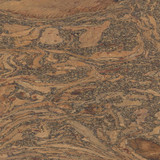Cork Flooring

Manufacture
You see, cork comes from the bark of the Cork Oak tree, Quercus
suber, which grows around the coast of the Mediterranean. These cork
trees generally live for between 150 and 200 years, and may not be
harvested until they are 25 years old. A law called “The Nine Year
Law,” passed in the 30’s, keeps them from being returned to for more
provisions for that length of time. Some of the bark is stripped off
the tree, with enough left to for it to sustain itself. The tree is
otherwise left alone, and the removed bark grows back. That which is
removed is left outside, where a natural reaction to the environment
strengthens the cork. In addition to coming from such a replenishing
source, cork flooring is made of the leftover materials from the
production of bottle stops, so none of the harvested bark is ever
wasted.
DurabilityWhile cork flooring is quite a bit softer than hardwood flooring, it is actually much more durable in one particular way – denting. Cork is basically the original memory foam. You can dent it, but over time it returns to its original form, as if it was a really slow sponge. It is particularly unspongelike when it comes to spills. A waxy material called suberin, which is the primary substance of which cork is made, pretty much keeps water from penetrating into the flooring. You just need to wipe the spill up, as you would under any other circumstance. Cork is very moisture resistant, but not 100% impervious to moisture, so do get those spills up in a timely manor. Still, the moisture resistance suberin brings is at a level that makes cork work well in places other floors cannot withstand like kitchens and bathrooms. |
 © Copyright Chris McAuley and licensed for reuse under this Creative Commons Licence.
© Copyright Chris McAuley and licensed for reuse under this Creative Commons Licence.
|
More Benefits
With or without the extra plywood subfloor, cork provides an insulation benefit that will not only lower your heating bill, but feel good to your feet. It warms the floor in the basement, and in the bathroom, two places where we want warm feet! Cork also suppresses sound better than woods, laminates and stone style flooring. The suberin also makes cork fire resistant, and odious to insects. In addition to resisting mold and mildew, its anti-static electricity nature means that cork flooring doesn’t hold onto air particulates, making it even more hypoallergenic.
– – – –
David has written and made videos about flooring products and installation since 2011 at Floors To Your Home (.com), where he is also the PPC Manager, a Researcher, a Website & Marketing Strategy Team member, Videographer, Social Strategist, Photographer and all around Resource Jito. In my spare time I shoot and edit video, put together a podcast, explore film history, and mix music (as in ‘play with Beatles multi-tracks’). Connect with
W. David Lichty
Follow Team Floors To Your Home on Facebook

 Brown Tone
Brown Tone
 Unfinished
Unfinished
 Red Tone
Red Tone
 Golden Tone
Golden Tone
 Gray Tone
Gray Tone
 Light Tone
Light Tone
 Medium Tone
Medium Tone
 Dark Tone
Dark Tone
 Brown Tone
Brown Tone
 Red Tone
Red Tone
 Golden Tone
Golden Tone
 Gray Tone
Gray Tone
 Light Tone
Light Tone
 Medium Tone
Medium Tone
 Dark Tone
Dark Tone
 Brown Tone
Brown Tone
 Red Tone
Red Tone
 Golden Tone
Golden Tone
 Gray Tone
Gray Tone
 Light Tone
Light Tone
 Medium Tone
Medium Tone
 Dark Tone
Dark Tone
 Multi Color
Multi Color



